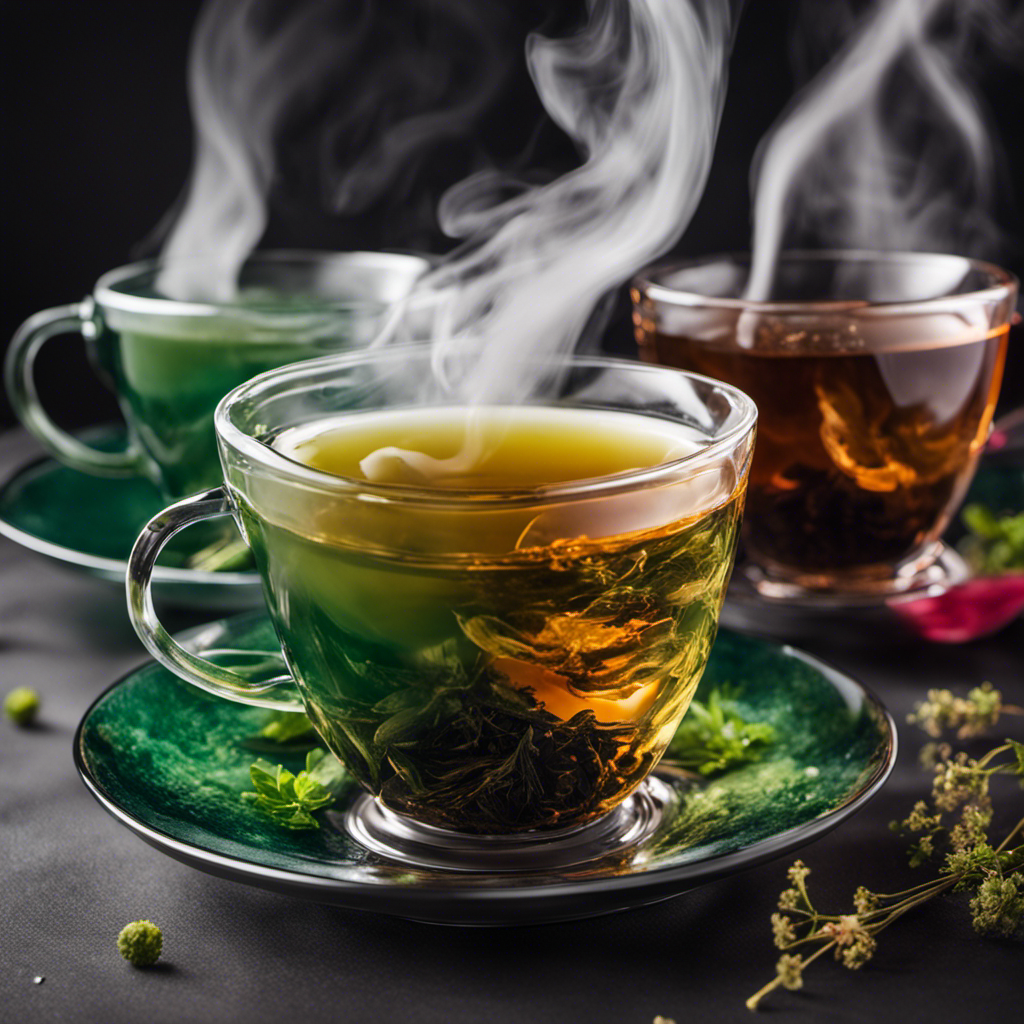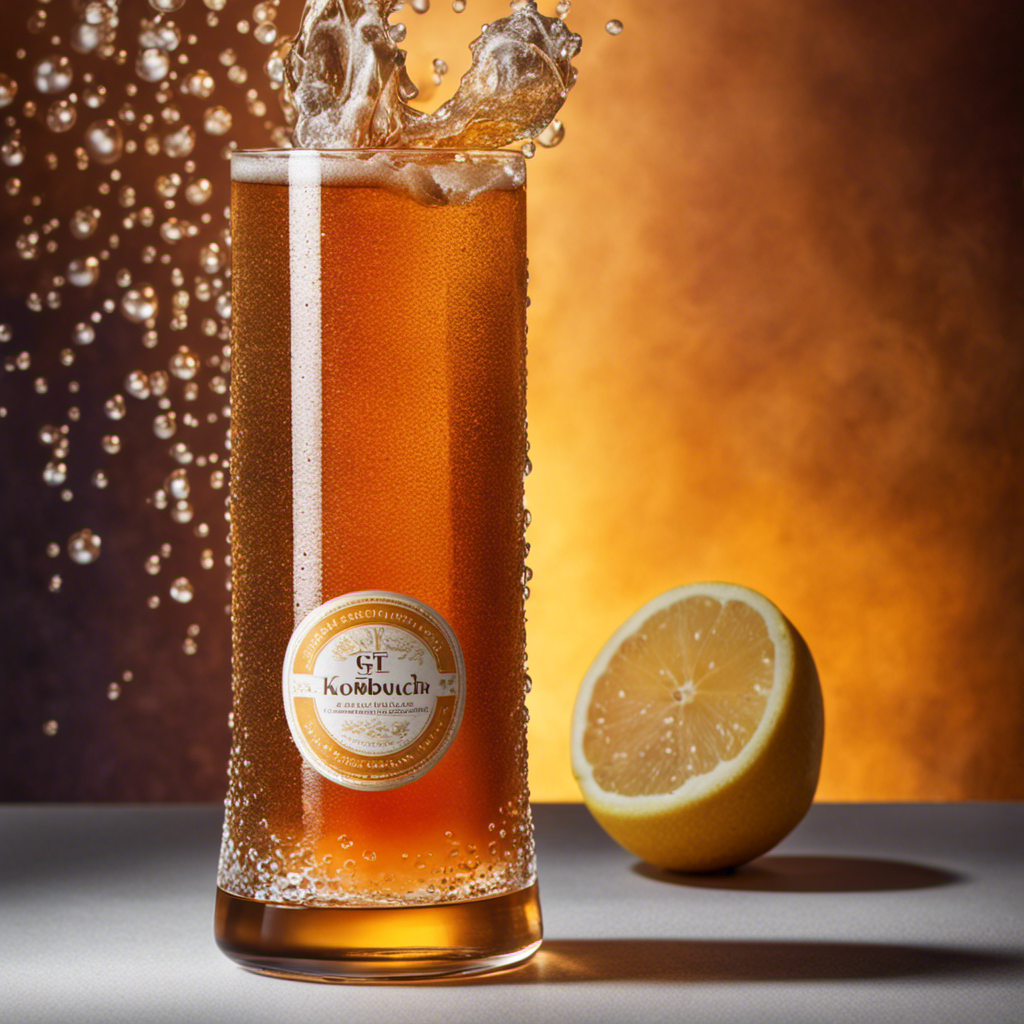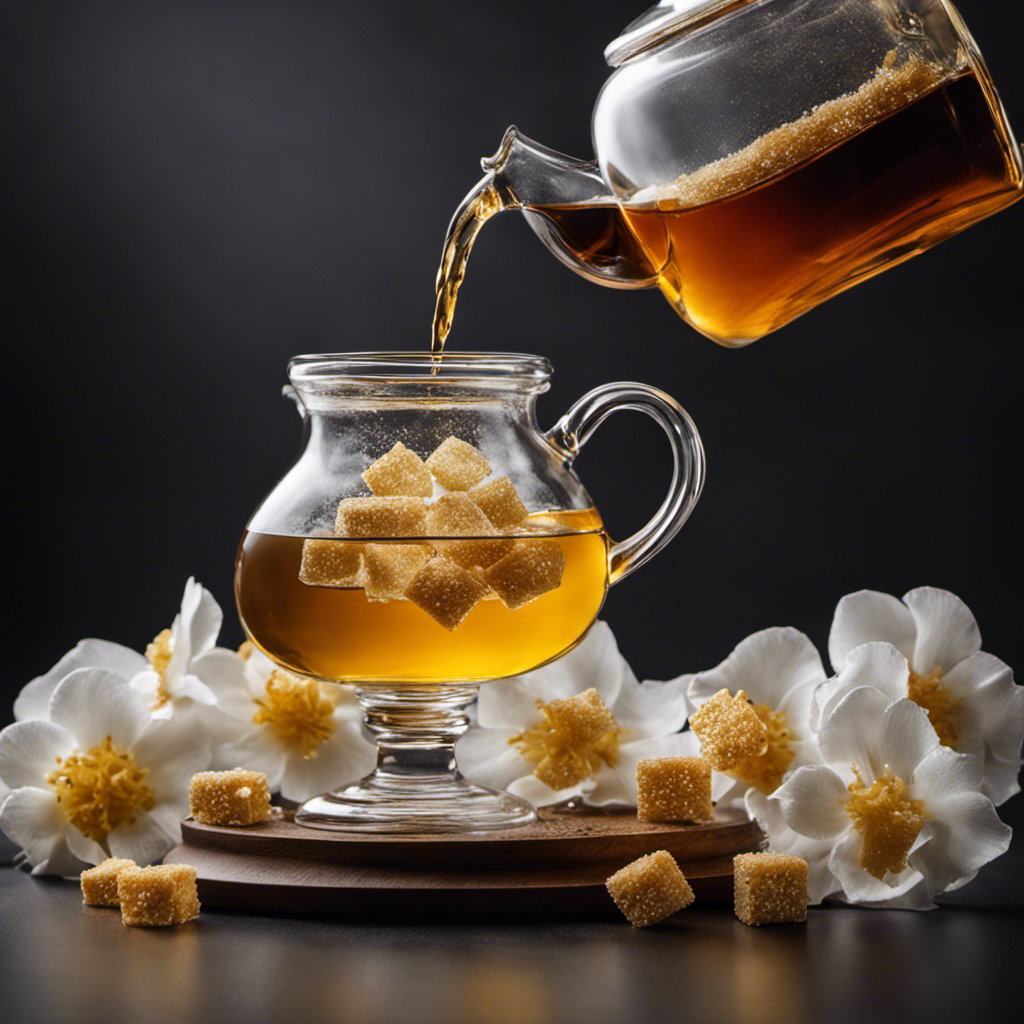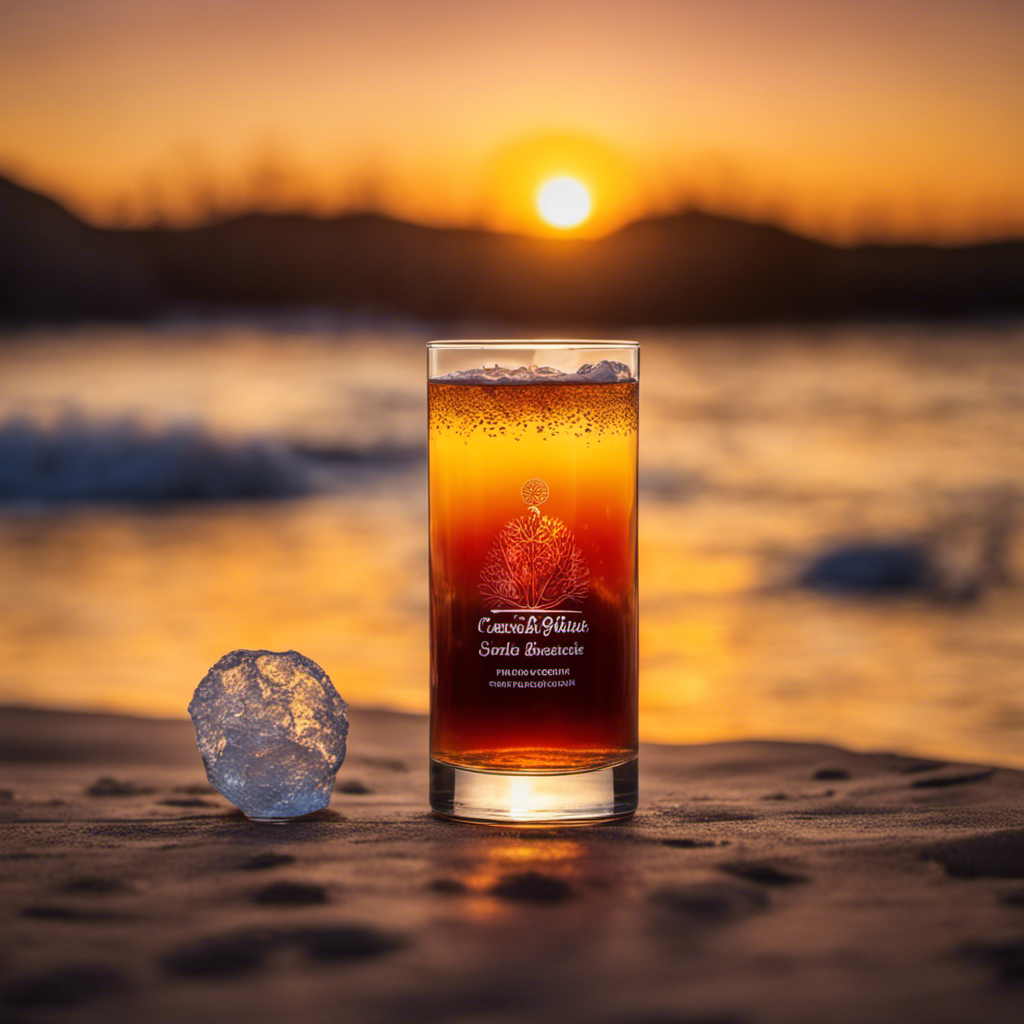Cappuccino
How To Use Cappuccino Stencils
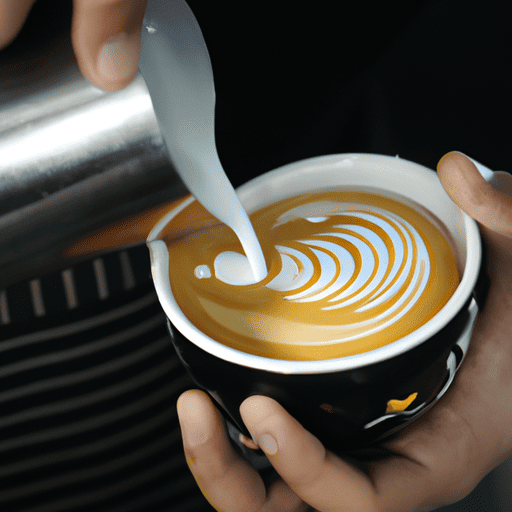
Hey there fellow coffee enthusiasts! Have you ever wondered how to create those beautiful designs on top of your cappuccinos? Well, wonder no more because today I am going to teach you just that.
Using cappuccino stencils is a fun and easy way to elevate your coffee game and impress your friends or customers.
First things first, it’s important to choose the right stencil for the design you want. There are a variety of stencils available online or at specialty stores that range from simple shapes like hearts or leaves to more intricate designs like animals or patterns.
Once you’ve picked out your stencil, it’s time to prepare your cappuccino by steaming the milk and creating a layer of foam on top. Don’t worry if you’re not an expert at latte art yet – the stencil will do most of the work for you!
So grab your favorite mug and let’s get started.
Key Takeaways
- Cappuccino stencils can be used to create intricate or simple designs for any occasion.
- Properly preparing the steamed milk and foam texture is crucial for achieving the desired design.
- Choosing the right stencil and powder is important for the desired design.
- Practice can lead to perfecting designs and even creating custom ones.
Choose the Right Stencil
You’ll want to pick out the perfect cappuccino stencil for your drink, allowing you to create a beautiful design that will impress anyone who sees it. It’s important to consider what kind of design you want and how intricate you want it to be.
There are many stencil designs available, from simple shapes like hearts and stars, to more complex designs like flowers or animals. You can also find stencils with words or phrases on them.
Once you’ve chosen your stencil, it’s time to learn some stenciling techniques. To start, make sure your cappuccino has a thick layer of foam on top. Hold the stencil over the foam and sprinkle cocoa powder or cinnamon onto the surface using a sifter.
Gently lift the stencil away and voila! You have an impressive design on your cappuccino that is sure to wow anyone who sees it. Now let’s move onto preparing your cappuccino so that it’s ready for stenciling.
Prepare Your Cappuccino
Before indulging in your perfect caffeinated treat, it’s important to properly prepare the steamed milk and espresso base. To start, you’ll need to froth your milk using one of several milk frothing techniques. This is crucial for achieving the desired texture of your foam and creating a canvas for cappuccino foam art.
To ensure that you’re on the right track, below is a table outlining some common milk frothing techniques. Each method produces a different texture of foam, so choose the one that best suits your taste or aesthetic preference:
| Milk Frothing Technique | Foam Texture |
|---|---|
| Steam Wand | Creamy |
| French Press | Light |
| Handheld Frother | Thick |
Now that you have successfully prepared your cappuccino with well-textured steamed milk and espresso base, it’s time to add a creative touch with cappuccino foam art. The next step is simple: place the stencil on top of the foam and begin sprinkling cocoa powder or cinnamon over it until a beautiful design emerges.
Place the Stencil on Top of the Foam
Now that your steamed milk and espresso base are perfectly prepared, it’s time to add some artistic flair by placing the stencil on top of the velvety foam. First, choose from a variety of stencil designs, such as hearts or leaves, that’ll complement your cappuccino.
As you hold the stencil above the foam, gently sprinkle cocoa powder over it until there’s an even coating on top of the foam. It’s important to note that the thickness of your foam can affect how well the design shows up on your cappuccino.
If your foam’s too thin, the cocoa powder may bleed through and create a messy design. On the other hand, if your foam’s too thick, it may be difficult to see any details in your stencil design.
Once you’ve placed and removed the stencil from atop your cappuccino, tap excess cocoa powder onto a nearby plate or napkin before moving onto the next step of tapping more cocoa powder onto the exposed parts of the foam.
Tap the Cocoa Powder onto the Foam
To add the finishing touch to your velvety foam, gently tap cocoa powder onto its surface in a circular motion, creating a beautiful and delicious design. This is where the real fun begins as you can get creative with different variations of stencils and alternative powders. Here are some ideas to get you started:
| Stencil Design | Powder Variation |
|---|---|
| Heart | Cinnamon |
| Leaf | Matcha powder |
| Star | Nutmeg |
Once you have tapped the powder onto the foam, carefully lift off the stencil to reveal your masterpiece! It’s important to remove it slowly and steadily to avoid any smudging or unwanted designs. Now that your cappuccino is beautifully decorated, it’s time to sit back, relax and enjoy every sip!
Remove the Stencil and Enjoy Your Beautifully Decorated Cappuccino!
You can finally reveal your beautiful and creative design by carefully lifting off the stencil from your frothy cappuccino. It’s always exciting to see the finished product of all your hard work!
After removing the stencil, you can take a moment to admire your handiwork before savoring that first delicious sip.
Once you’re done admiring your masterpiece, it’s important to clean your stencils properly so they’ll be ready for the next round of cappuccinos. To clean them, simply rinse with warm water and wipe dry with a cloth or paper towel. If there’s any stubborn residue left on the stencil, use a soft-bristled brush or toothbrush to gently scrub it away.
With practice, you’ll be able to perfect your designs and even create custom ones!
Frequently Asked Questions
Where can I purchase cappuccino stencils?
I found that both online and in-store options offer a variety of cappuccino stencils. My favorite designs for creating latte art are the classic heart and leaf shapes.
How do I clean my cappuccino stencils?
For stencil maintenance, I clean my cappuccino stencils after every use with warm water and a soft brush. If there’s stubborn residue, I use dish soap or vinegar. Avoid harsh chemicals that may damage the stencil design.
Can I use other types of powders, such as cinnamon or nutmeg, instead of cocoa powder?
Yes, I love using alternative powders like cinnamon and nutmeg to create unique designs with my cappuccino stencils. It adds an extra touch of creativity to my drinks and impresses my guests.
What should I do if the cocoa powder doesn’t come out evenly?
If the cocoa powder doesn’t come out evenly, I adjust my technique by holding the stencil closer to the surface and tapping it lightly. If that doesn’t work, I try using alternative powders like cinnamon or nutmeg.
Can I reuse the stencil after tapping the powder onto the foam?
Yes, I can reuse the stencil after tapping the powder onto the foam. However, I always make sure to clean it thoroughly before using it again. If cocoa powder doesn’t work well, I use powdered sugar or cinnamon as alternatives. Cleaning stencils is important for their longevity and hygiene.
Conclusion
Well, there you have it! Using cappuccino stencils is a fun and easy way to add some flair to your morning coffee routine. With just a few simple steps, you can create beautiful designs on top of your foam that are sure to impress your friends and family.
As I sipped my perfectly decorated cappuccino, I couldn’t help but feel a sense of pride in my newfound barista skills. The delicate lines and intricate patterns on top of my drink were like works of art, each one unique and beautiful in its own way. It was as if I had created a masterpiece with just a few taps of cocoa powder.
In conclusion, using cappuccino stencils is an enjoyable way to elevate your coffee game. So why not try it out for yourself? Who knows – you might discover a hidden talent for latte art that you never knew existed!
In the vast and diverse world of coffee, coffee alternatives, and tea, Olivia has found her calling. As an author and a dedicated coffee and tea aficionado, her work for Cappuccino Oracle reflects her profound love and understanding of the intricate complexities found within these beverages. Olivia’s passion for the subject serves as both a catalyst for her creativity and a connection point with her audience.
Olivia’s appreciation for coffee, coffee alternatives, and tea blossomed at an early age. She discovered that these beverages invigorated her senses and stimulated her creative spirit. From the nuanced flavors of single-origin roasts to the captivating narratives intertwined with coffee, coffee alternatives, and tea trade and culture, Olivia found an unlimited source of inspiration in her daily cup.
Her love for these beverages and her talent for storytelling eventually converged at Cappuccino Oracle. As an author, Olivia’s mission is to illuminate the intricate tapestry that makes up the world of coffee, coffee alternatives, and tea. Her articles span a diverse range of topics, encompassing everything from the unique flavors of different brews to the sociocultural history intertwined with their cultivation and consumption.
Cappuccino
Discover the Rich History and Perfect Techniques Behind the Irresistible Cappuccino

I have always thought that a delicious cup of cappuccino has the ability to improve any day. With its bold espresso and creamy steamed milk, it’s a soothing treat that never fails to brighten my mood.
In this article, I’ll share the origins of cappuccino, a traditional recipe, and techniques for perfecting your own cup. Whether you’re a coffee connoisseur or simply enjoy a good brew, get ready to elevate your cappuccino game to new heights.
Key Takeaways
- Cappuccino originated in Italy in the 17th century and was enjoyed by the upper class.
- The name ‘cappuccino’ is believed to have come from the Capuchin friars.
- The traditional recipe consists of equal parts espresso, steamed milk, and milk foam.
- Steaming the milk at the ideal temperature and pouring it slowly creates a creamy and frothy texture.
The Origins of Cappuccino
I love learning about the origins of cappuccino and how it became such a popular coffee drink.
The history of cappuccino dates back to the 17th century in Italy. It’s believed that the name ‘cappuccino’ was derived from the Capuchin friars, who wore brown hoods that resembled the color of the coffee.
Initially, cappuccino was made with equal parts of espresso, steamed milk, and milk foam. It was a drink enjoyed by the upper class and was often served after dinner.
Over time, cappuccino spread across Europe and eventually made its way to America. Today, it has become a staple in coffee shops worldwide, reflecting the influence of Italian culture on coffee consumption around the globe.
The history and culture behind cappuccino make it a fascinating and beloved beverage.
Traditional Cappuccino Recipe
Sometimes, I like to make a traditional cappuccino using the classic recipe of equal parts espresso, steamed milk, and milk foam. This iconic drink has been a staple in coffeehouse culture for decades, known for its perfect balance of flavors and velvety texture. When crafting my cappuccino, I start by pulling a shot of rich espresso, with its bold aroma and intense flavor. Then, I carefully steam the milk to create a creamy and frothy texture. Finally, I pour the milk over the espresso, creating the perfect ratio of coffee to milk. The result is a delightful beverage that combines the strong notes of espresso with the smoothness of steamed milk. It’s no wonder that the classic cappuccino continues to be a favorite among coffee lovers in the vibrant coffeehouse culture.
Espresso Steamed Milk Milk Foam Rich Creamy Frothy
Techniques for Steaming Milk
To achieve the perfect texture, it’s important to carefully steam the milk with the correct technique. Steaming milk is a crucial step in creating a delicious cappuccino or latte.
Here are some common mistakes to avoid and some milk frothing tools to help you achieve that velvety smooth microfoam:
-
Not using fresh, cold milk: Fresh milk produces the best results, so avoid using milk that has been sitting out for too long.
-
Incorrect temperature: The ideal steaming temperature for milk is between 140-160°F. Anything above or below can affect the taste and texture.
-
Improper positioning of the steam wand: Position the steam wand slightly off-center and just below the surface of the milk to create a whirlpool effect.
-
Oversteaming: Oversteaming the milk can result in large bubbles and a thin, frothy texture. Aim for small, uniform bubbles.
-
Using the wrong frothing tools: Invest in a good quality frothing pitcher and thermometer to ensure precision and consistency in your milk steaming process.
Creative Cappuccino Variations
Experimenting with unique flavor combinations and adding a touch of creativity can elevate your cappuccino variations to new levels of deliciousness. When it comes to cappuccinos, the possibilities are endless. From classic vanilla and caramel to more adventurous flavors like lavender and gingerbread, there are plenty of options to suit every taste.
But it’s not just about the flavors; presentation is also key. Cappuccino art has become increasingly popular, with baristas showcasing their skills by creating intricate designs on the foam. Whether it’s a heart, a leaf, or even a cute animal, these little details add an extra touch of beauty to your cup.
Tips for Perfecting Your Cappuccino
I love adding a dash of cinnamon and a sprinkle of cocoa to my cappuccino, it’s the perfect way to enhance the flavor. But there’s more to a perfect cappuccino than just the taste.
Achieving the ideal foam consistency and mastering latte art techniques are essential for a truly exceptional cup of coffee. Here are some tips to help you perfect your cappuccino:
- Use fresh, high-quality espresso beans for the best flavor.
- Froth the milk to achieve a creamy and velvety texture.
- Pour the milk slowly and steadily into the espresso to create a beautiful layered effect.
- Experiment with different designs for latte art, like hearts, rosettas, or even intricate patterns.
- Practice your technique to ensure consistent and impressive results every time.
By paying attention to foam consistency and mastering latte art techniques, you can elevate your cappuccino experience and impress your friends with your barista skills.
Frequently Asked Questions
What Is the Caffeine Content in a Cup of Cappuccino?
The caffeine content in a cup of cappuccino can vary depending on the size and the type of coffee used. However, compared to other caffeinated beverages, cappuccino generally has less caffeine.
Can I Make Cappuccino Without an Espresso Machine?
Can I make cappuccino without an espresso machine? Absolutely! There are alternative methods for making cappuccino at home, such as using a French press or a handheld milk frother. It’s all about finding what works for you.
What Is the Difference Between a Cappuccino and a Latte?
The difference between a cappuccino and a latte lies in the ratios of espresso, steamed milk, and foam. While a cappuccino has equal parts of each, a latte has more steamed milk and less foam.
Are There Any Health Benefits Associated With Drinking Cappuccino?
Drinking cappuccino may have some health benefits, but it’s important to be cautious. Consuming too much can lead to potential risks, and it may also impact sleep quality. Moderation is key.
Can I Use Plant-Based Milk Alternatives for Making Cappuccino?
Yes, you can definitely use plant-based milk alternatives for making cappuccino. There are various options like almond milk, soy milk, and oat milk that can be used to create delicious and creamy alternative coffee beverages.
Conclusion
In the world of coffee, cappuccino stands as a timeless classic. Its origins, steeped in Italian tradition, have paved the way for endless creative variations. With the perfect balance of steamed milk and expertly pulled espresso, a cappuccino becomes a symphony of flavors, a rich and creamy dance on the taste buds.
So, whether you prefer a traditional recipe or a unique twist, mastering the art of cappuccino will always bring joy to your mornings.
Arf, an author and an innovative enthusiast of coffee, coffee alternatives, and tea, plays a crucial role as a contributor to the esteemed Cappuccino Oracle platform. Renowned for his curiosity and passion for these captivating beverages, Arf has carved out a unique space for himself in the world of exploration and writing. He realized that coffee, coffee alternatives, and tea are not mere drinks to keep one awake, but universes of flavors and stories waiting to be explored.
Arf’s articles for Cappuccino Oracle blend meticulous research with personal experiences, providing readers with an in-depth understanding of various types of coffee, coffee alternatives, and tea, along with their unique characteristics, cultures, and histories. His honest reviews and engaging narratives guide readers on their own journeys, helping them discover their preferences and find their perfect brew.
Cappuccino
The Cultural History Of Cappuccino: A Perfect Morning Cup

Beginning my day with a cappuccino is something I truly enjoy. Its luxurious fragrance, creamy feel, and the ideal mix of espresso, steamed milk, and foam create the perfect morning treat.
But have you ever wondered about the cultural history behind this beloved beverage? Well, let me take you on a journey through time as we explore the origins, evolution, and popularity of cappuccino.
Dating back more than 400 years, cappuccino has its roots in Austria and Italy, where it was named after the Capuchin friars. Over the years, it has transformed from a simple coffee drink to a work of art, thanks to the invention of the espresso machine.
Today, cappuccino is enjoyed not only in the morning, but throughout the day, in various settings, from local cafes to high-end coffee shops.
So, grab your favorite mug, sit back, and join me as we delve into the cultural history of cappuccino – the perfect morning cup.
Key Takeaways
- Cappuccino originated in Austria and Italy and is named after the Capuchin friars.
- The modern version of cappuccino evolved after the invention of the espresso machine.
- Cappuccino is traditionally a morning drink but is now enjoyed throughout the day.
- Cappuccino can be customized with flavorings and can be enjoyed in various settings.
Origin and Evolution
I know that cappuccino originated in Austria as kapuziner and in Italy as cappuccino, named after the Capuchin friars, and evolved into its modern form after the invention of the espresso machine. The influence of these two countries can still be seen in the way cappuccino is enjoyed today.
In Austria, the kapuziner was made with equal parts coffee and milk, while in Italy, cappuccino was made with equal parts espresso, steamed milk, and milk foam. This traditional recipe is still followed in many places, but there are also modern variations that have emerged.
Some variations include using hot milk instead of steamed milk, adding flavorings such as vanilla or caramel, or even using cream instead of milk. These variations have made cappuccino a versatile and customizable drink that can be enjoyed by coffee lovers all over the world.
Ingredients and Preparation
Crafting a cappuccino involves combining carefully measured amounts of espresso, steamed milk, and velvety milk foam. The choice of milk for a cappuccino is crucial in achieving the perfect balance of flavors and textures. Whole milk is commonly used for its creamy richness, but some prefer to use lower fat options like skim or soy milk. Each type of milk imparts a slightly different taste and texture to the cappuccino.
When it comes to flavorings, some people enjoy adding flavored syrups to their cappuccino for a touch of sweetness or a unique twist. However, there are pros and cons to using flavored syrups. On one hand, they can enhance the taste and create a more personalized experience. On the other hand, they can overpower the natural flavors of the espresso and milk. Ultimately, the decision to use flavored syrups in a cappuccino is a matter of personal preference.
Popularity and Enjoyment
To truly appreciate the popularity and enjoyment of this beloved beverage, one must delve into its cultural significance and historical roots. Cappuccino has not only gained popularity as a morning drink but has also become a symbol of the coffee culture worldwide. It has been embraced and adapted by different countries, resulting in unique variations that reflect their own cultural preferences.
Here are some examples:
1) Italy: Cappuccino is deeply ingrained in Italian culture and is commonly enjoyed with breakfast. Italians take great pride in their coffee craftsmanship and often create stunning latte art on top of their cappuccinos.
2) United States: In America, the iced cappuccino has gained immense popularity, especially during the warmer months. It is a refreshing twist on the traditional hot version and is often enjoyed as an afternoon pick-me-up.
3) Greece: Here, the frappé cappuccino is a favorite among locals and tourists alike. It is made with instant coffee, sugar, water, milk, and ice, creating a frothy and delicious drink perfect for hot summer days.
4) Australia: Australians have their own version called the ‘flat white,’ which is made with a double shot of espresso and velvety microfoam. It has gained a cult following and is considered a staple in Australian coffee culture.
These global variations highlight the cultural significance and adaptability of cappuccino, making it a beloved beverage enjoyed by people from all walks of life.
Frequently Asked Questions
How did the name "cappuccino" come about?
The name ‘cappuccino’ originated from the Italian influence and was derived from the Capuchin friars. This interesting fact reveals the historical connection between the drink and the Capuchin order, adding depth to its cultural significance.
What are some common misconceptions about cappuccino?
Some common misconceptions about cappuccino include thinking that it is only a morning drink and that it is the same as a latte. Cappuccino can be enjoyed at any time of day and has a different ratio of ingredients than a latte.
Are there any health benefits associated with drinking cappuccino?
Drinking cappuccino in moderation may have potential health benefits. Some studies suggest cappuccino may promote heart health due to its antioxidant content. Additionally, the ritual of enjoying a cappuccino can contribute to mental well-being and relaxation.
How has the cultural significance of cappuccino evolved over time?
The cultural significance of cappuccino has evolved over time. It has become more than just a morning drink, now enjoyed throughout the day. Cappuccino has also become a popular icon in popular culture, often depicted in movies and TV shows.
Are there any regional variations of cappuccino?
Oh, the regional variations of cappuccino are truly a delightful journey for the taste buds! From the rich and creamy cappuccino freddo in Italy to the indulgent iced cappuccino in America, each culture adds its own twist to this beloved beverage. The cultural significance of these variations showcases the adaptability and creativity of coffee lovers worldwide.
Arf, an author and an innovative enthusiast of coffee, coffee alternatives, and tea, plays a crucial role as a contributor to the esteemed Cappuccino Oracle platform. Renowned for his curiosity and passion for these captivating beverages, Arf has carved out a unique space for himself in the world of exploration and writing. He realized that coffee, coffee alternatives, and tea are not mere drinks to keep one awake, but universes of flavors and stories waiting to be explored.
Arf’s articles for Cappuccino Oracle blend meticulous research with personal experiences, providing readers with an in-depth understanding of various types of coffee, coffee alternatives, and tea, along with their unique characteristics, cultures, and histories. His honest reviews and engaging narratives guide readers on their own journeys, helping them discover their preferences and find their perfect brew.
Cappuccino
The Adventures of Espresso, Milk, and Foam: A Tale of Cappuccino Creation

In a parallel universe not too far from our own, the magical land of Coffeelandia is home to an array of coffee ingredients with unique personalities and desires. This is a tale of adventure and unity, where the heroes – Espresso, Milk, and Foam – come together to create the perfect cappuccino.
Chapter 1: The Bold Espresso
Espresso, a bold and intense character, resided in the heart of Coffeelandia. He was known for his daring spirit and ability to energize those around him. One day, Espresso was invited to the annual Coffeelandia Gala, where the finest coffee ingredients gathered to form the most exquisite beverages. Intrigued by the challenge, Espresso embarked on a journey to find the perfect companions to create a legendary cappuccino.

Chapter 2: The Creamy Milk
Espresso’s quest led him to Dairyland’s lush, green pastures, where he met the charming and gentle Milk. With her velvety texture and subtle sweetness, Milk was the ideal partner to balance Espresso’s intensity. Milk agreed to join Espresso on his adventure, excited to showcase her talents at the Coffeelandia Gala. Together, they set off to find the final member of their cappuccino trio.
Chapter 3: The Fluffy Foam
Upon reaching the Cloudy Peaks, Espresso and Milk encountered Foam, an airy and playful character known for his ability to bring lightness and joy to everyone he met. As they spoke with Foam, they realized that his airy nature would perfectly contrast their rich and creamy blend. Filled by the opportunity to be part of a legendary cappuccino, Foam eagerly agreed to join Espresso and Milk on their journey.
Chapter 4: The Cappuccino Trio Unites
With the trio united, Espresso, Milk, and Foam ventured back to Coffeelandia, where they practiced their harmonious collaboration. Espresso discovered that by combining his intensity with Milk’s smoothness and Foam’s lightness, they formed an extraordinary symphony of flavors and textures. They perfected their roles, with Espresso as the strong foundation, Milk as the velvety layer, and Foam as the delicate, cloud-like finish.

Chapter 5: The Coffeelandia Gala
The long-awaited night of the Coffeelandia Gala arrived, and the cappuccino trio took center stage. As they came together, their individual strengths fused into a dazzling spectacle, creating a cappuccino that enchanted the audience. The rich aroma, velvety texture, and harmonious taste mesmerized the crowd, earning them the coveted title of “The Perfect Cappuccino.”

Conclusion
The adventures of Espresso, Milk, and Foam remind us that despite our differences, unity and collaboration can lead to extraordinary creations. Their story is a testament to the power of friendship, and their legendary cappuccino will forever be remembered as a symbol of harmony in the magical land of Coffeelandia.
Noah, the Editor-in-Chief at Cappuccino Oracle, plays a pivotal role in shaping the voice and vision of our renowned platform. With an unwavering passion for coffee, coffee alternatives, and tea, Noah leads Cappuccino Oracle towards new horizons in the realm of coffee journalism.
Beyond his professional responsibilities, Noah serves as a mentor and guiding force for his team. His dedication to journalistic excellence and genuine love for coffee, coffee alternatives, and tea continue to inspire and motivate the Cappuccino Oracle family. In the ever-evolving world of these beverages, Noah’s leadership ensures that our platform remains at the forefront, delivering enlightening and enjoyable content to our readers worldwide.
-

 Americano4 weeks ago
Americano4 weeks agoHow to Make Americano With Moka Pot
-

 Americano2 weeks ago
Americano2 weeks agoHow to Make Korean Iced Americano
-

 Americano4 weeks ago
Americano4 weeks agoHow to Make Iced Americano With Instant Coffee
-

 Americano4 weeks ago
Americano4 weeks agoHow to Make Americano With Bialetti
-

 Americano4 weeks ago
Americano4 weeks agoHow to Make Dutch Bros Americano
-

 Americano6 days ago
Americano6 days agoHow to Make an Iced Americano With Nespresso
-

 Americano2 weeks ago
Americano2 weeks agoHow Many Shots of Espresso for 16 Oz Americano
-

 Americano4 weeks ago
Americano4 weeks agoHow to Make a Hazelnut Americano








